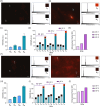MicroMetaSense: Coupling Plasmonic Metasurfaces with Fluorescence for Enhanced Detection of Microplastics in Real Samples
- PMID: 39729532
- PMCID: PMC11877509
- DOI: 10.1021/acssensors.4c02070
MicroMetaSense: Coupling Plasmonic Metasurfaces with Fluorescence for Enhanced Detection of Microplastics in Real Samples
Abstract
Diverse analytical techniques are employed to scrutinize microplastics (MPs)─pervasive at hazardous concentrations across diverse sources ranging from water reservoirs to consumable substances. The limitations inherent in existing methods, such as their diminished detection capacities, render them inadequate for analyzing MPs of diminutive dimensions (microplastics: 1-5 μm; nanoplastics: < 1 μm). Consequently, there is an imperative need to devise methodologies that afford improved sensitivity and lower detection limits for analyzing these pollutants. In this study, we introduce a holistic strategy, i.e., MicroMetaSense, reliant on a metal-enhanced fluorescence (MEF) phenomenon in detecting a myriad size and types of MPs (i.e., poly(methyl methacrylate) (PMMA) and poly(ethylene terephthalate) (PET)) down to 183-205 fg, as well as validated the system with real samples (tap and lake) and artificial ocean samples as a real-world scenario. To obtain precise size distribution in nanometer scale, MPs are initially processed with an ultrafiltration on-a-chip method, and subsequently, the MPs stained with Nile Red dye are subjected to meticulous analysis under a fluorescence microscope, utilizing both a conventional method (glass substrate) and the MicroMetaSense platform. Our approach employs a metasurface to augment fluorescence signals, leveraging the MEF phenomenon, and it demonstrates an enhancement rate of 36.56-fold in detecting MPs compared to the standardized protocols. This low-cost ($2), time-saving (under 30 min), and highly sensitive (183-205 femtogram) strategy presents a promising method for precise size distribution and notable improvements in detection efficacy not only for laboratory samples but also in real environmental samples; hence, signifying a pivotal advancement in conventional methodologies in MP detection.
Keywords: fluorescence microscopy; metal-enhanced fluorescence; microplastics; nanoplastics; plasmonic metasurfaces.
Conflict of interest statement
The authors declare no competing financial interest.
Figures







Similar articles
-
Tracing microplastics from raw water to drinking water treatment plants in Busan, South Korea.Sci Total Environ. 2022 Jun 15;825:154015. doi: 10.1016/j.scitotenv.2022.154015. Epub 2022 Feb 19. Sci Total Environ. 2022. PMID: 35189238
-
A cost-effective and efficient fluorescence staining agent for the identification of microplastics in environmental samples and zebrafish (Danio rerio).J Hazard Mater. 2025 Aug 5;493:138365. doi: 10.1016/j.jhazmat.2025.138365. Epub 2025 Apr 21. J Hazard Mater. 2025. PMID: 40267718
-
Occurrence and distribution of microplastics in China's largest freshwater lake system.Chemosphere. 2020 Dec;261:128186. doi: 10.1016/j.chemosphere.2020.128186. Epub 2020 Aug 29. Chemosphere. 2020. PMID: 33113661
-
Exploring Innovative Approaches for the Analysis of Micro- and Nanoplastics: Breakthroughs in (Bio)Sensing Techniques.Biosensors (Basel). 2025 Jan 13;15(1):44. doi: 10.3390/bios15010044. Biosensors (Basel). 2025. PMID: 39852095 Free PMC article. Review.
-
Global occurrence characteristics, drivers, and environmental risk assessment of microplastics in lakes: A meta-analysis.Environ Pollut. 2024 Mar 1;344:123321. doi: 10.1016/j.envpol.2024.123321. Epub 2024 Jan 5. Environ Pollut. 2024. PMID: 38185354 Review.
References
-
- Tudor V. C.; Marin A.; Vasca D. Z.; Micu M. M.; Smedescu D. I. The Influence of the Plastic Bags on the Environment. Mater. Plast. 2018, 55 (4), 595.10.37358/MP.18.4.5081. - DOI
-
- Ncube L. K.; Ude A. U.; Ogunmuyiwa E. N.; Zulkifli R.; Beas I. N. An Overview of Plastic Waste Generation and Management in Food Packaging Industries. Recycling 2021, 6 (1), 12.10.3390/recycling6010012. - DOI
Publication types
MeSH terms
Substances
LinkOut - more resources
Full Text Sources
Miscellaneous

